Dragging Core2Duo into 2013: Time for an Upgrade?
by Ian Cutress on January 15, 2013 12:30 PM EST- Posted in
- CPUs
As any ‘family source of computer information’ will testify, every so often a family member will want an upgrade. Over the final few months of 2012, I did this with my brother’s machine, fitting him out with a Sandy Bridge CPU, an SSD and a good GPU to tackle the newly released Borderlands 2 with, all for free. The only problem he really had up until that point was a dismal FPS in RuneScape.
The system he had been using for the two years previous was an old hand-me-down I had sold him – a Core2Duo E6400 with 2x2 GB of DDR2-800 and a pair of Radeon HD4670s in Crossfire. While he loves his new system with double the cores, a better GPU and an SSD, I wondered how much of an upgrade it had really been.
I have gone through many upgrade philosophies over the decade. My current one to friends and family that ask about upgrades is that if they are happy installing new components. then upgrade each component to one of the best in its class one at a time, rather than at an overall mediocre setup, as much as budget allows. This tends towards outfitting a system with a great SSD, then a GPU, PSU, and finally a motherboard/CPU/memory upgrade with one of those being great. Over time the other two of that trio also get upgraded, and the cycle repeats. Old parts are sold and some cost is recouped in the process, but at least some of the hardware is always on the cutting edge, rather than a middling computer shop off-the-shelf system that could be full of bloatware and dust.
As a result of upgrading my brother's computer, I ended up with his old CPU/motherboard/memory combo, full of dust, sitting on top of one of my many piles of boxes. I decided to pick it up and run the system with a top range GPU and an SSD through my normal benchmarking suite to see how it faired to the likes of the latest FM2 Trinity and Intel offerings, both at stock and with a reasonable overclock. Certain results piqued my interest, but as for normal web browsing and such it still feels as tight as a drum.
The test setup is as follows:
Core2Duo E6400 – 2 cores, 2.13 GHz stock
2x2 GB OCZ DDR2 PC8500 5-6-6
MSI i975X Platinum PowerUp Edition (supports up to PCIe 1.1)
Windows 7 64-bit
AMD Catalyst 12.3 + NVIDIA 296.10 WHQL (for consistency between older results)
My recent testing procedure in motherboard reviews pairs the motherboard with an SSD and a HD7970/GTX580, and given my upgrading philosophy above, I went with these for comparable results. The other systems in the results used DDR3 memory in the range of 1600 C9 for the i3-3225 to 2400 C9 for the i7-3770K.
The Core2Duo system was tested at stock (2.13 GHz and DDR2-533 5-5-5) and with a mild overclock (2.8 GHz and DDR2-700 5-5-6).
Gaming Benchmarks
Games were tested at 2560x1440 (another ‘throw money at a single upgrade at a time’ possibility) with all the eye candy turned up, and results were taken as the average of four runs.
Metro2033
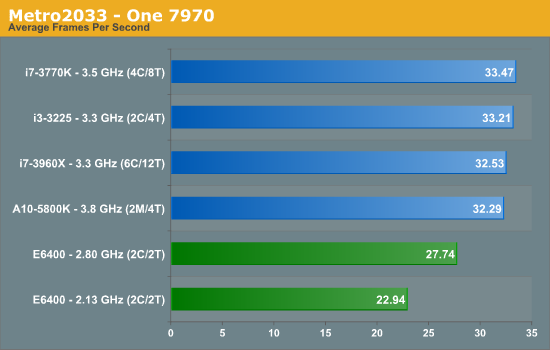
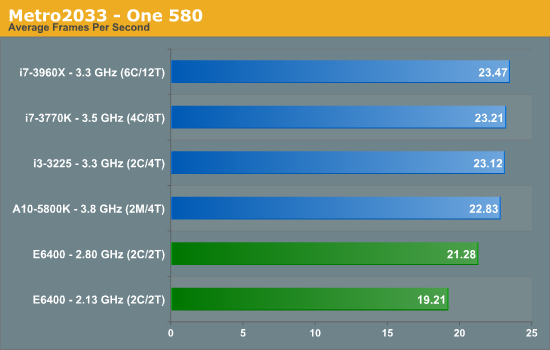
While an admirable effort by the E6400, and overclocking helps a little, the newer systems get that edge. Interestingly the difference is not that much, with an overclocked E6400 being within 1 FPS of an A10-5800K at this resolution and settings while using a 580.
Dirt3
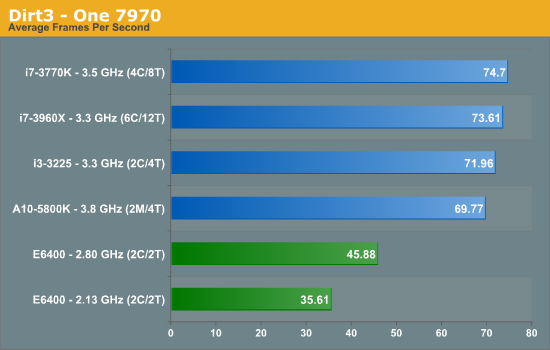

The bump by the overclock makes Dirt3 more playable, but it still lags behind the newer systems.
Computational Benchmarks
3D Movement Algorithm Test
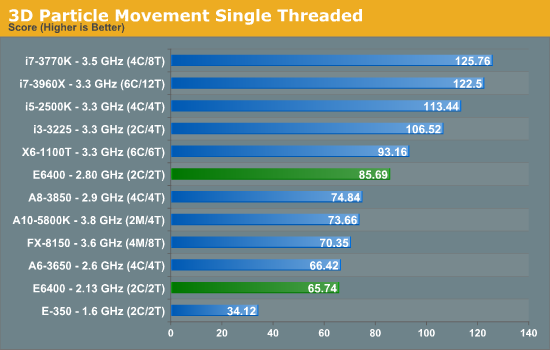
This is where it starts to get interesting. At stock the E6400 lags at the bottom but within reach of an FX-8150 4.2 GHz , but with an overclock the E6400 at 2.8 GHz easily beats the Trinity-based A10-5800K at 4.2 GHz. Part of this can be attributed to the way the Bulldozer/Piledriver CPUs deal with floating point calculations, but it is incredible that a July 2006 processor can beat an October 2012 model. One could argue that a mild bump on the A10-5800K would put it over the edge, but in our overclocking of that chip anything above 4.5 GHz was quite tough (we perhaps got a bad sample to OC).
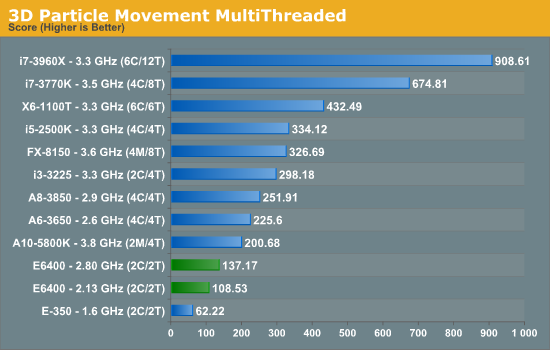
Of course the situation changes when we hit the multithreaded benchmark, with the two cores of the E6400 holding it back. However, if we were using a quad core Q6600, stock CPU performance would be on par with the A10-5800K in an FP workload, although the Q6600 would have four FP units to calculate with and the A10-5800K only has two (as well as the iGPU).
WinRAR x64 3.93 - link

In a variable threaded workload, the DDR2 equipped E6400 is easily outpaced by any modern processor using DDR3.
FastStone Image Viewer 4.2 - link
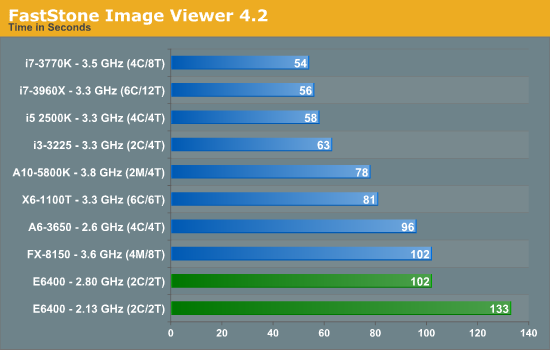
Despite FastStone being single threaded, the increased IPC of the later generations usually brings home the bacon - the only difference being the Bulldozer based FX-8150, which is on par with the E6400.
Xilisoft Video Converter
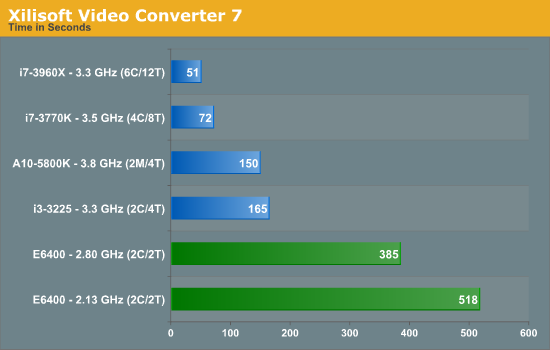
Similarly with XVC, more threads and INT workloads win the day.
x264 HD Benchmark
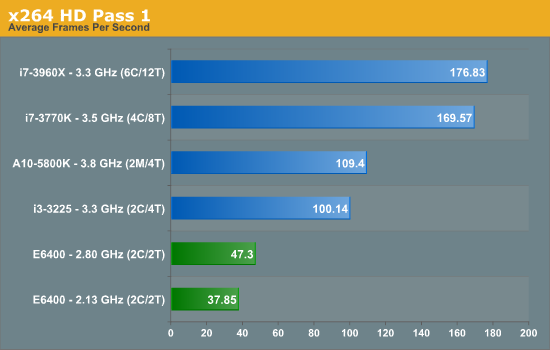
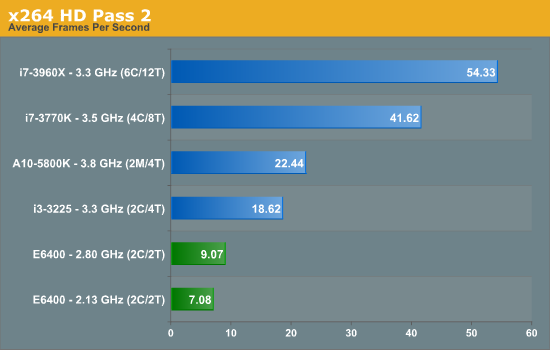
Conclusions
When I start a test session like this, my first test is usually 3DPM in single thread mode. When I got that startling result, I clearly had to dig deeper, but the conclusion produced by the rest of the results is clear. In terms of actual throughput benchmarks, the E6400 is comparatively slow to all the modern home computer processors, either limited by cores or by memory.
This was going to be obvious from the start.
In the sole benchmark which does not rely on memory or thread scheduling and is purely floating point based the E6400 gives a surprise result, but nothing more. In our limited gaming tests the E6400 copes well at 2560x1440, with that slight overclock making Dirt3 more playable.
But the end result is that if everything else is upgraded, and the performance boost is cost effective, even a move to an i3-3225 or A10-5800K will yield real world tangible benefits, alongside all the modern advances in motherboard features (USB 3.0, SATA 6 Gbps, mSATA, Thunderbolt, UEFI, PCIe 2.0/3.0, Audio, Network). There are also significant power savings to be had with modern architectures.
My brother enjoys playing his games at a more reasonable frame rate now, and he says normal usage has sped up by a bit, making watching video streams a little smoother if anything. The only question is where Haswell will come in to this, and is a question I look forward to answering.


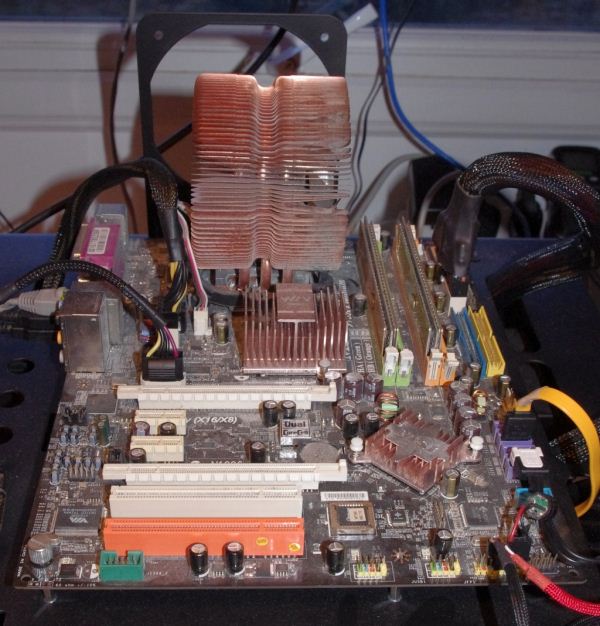








136 Comments
View All Comments
jabber - Wednesday, January 16, 2013 - link
...shame that the benches here are totally pointless in regards to the usual situation of 'hand me down PCS'.Would have been more useful to see testing on how fast a Word document opens and closes compared to a top end i7. How fast Facebook opens, maybe how playable the Sims was on both machines, Farmville performance.
Thats more real world stuff that normal people do. I'm pretty sure the results would have been negligible.
Yes the tests show how far things have advanced but they don't address how pointless all that extra power is for 95% of users in general and 99.999% of hand me down owners.
Most I do now in such cases is just make sure it had a dual core, at least 2GB of ram and maybe slap a cheap SSD in it. Good to go for quite some time.
Second point is I'm intrigued to know what your brothers home looks like. Thats one dusty PC for 2 years of use. I can always tell what a persons home looks like when they bring me a PC. If its 5 years old and spotless inside, the home 99 times out of a 100 is spotless too. If it arrives full of dust and spiders then I know its a hell hole. Proven when I arrive to take it back and I don't stop long.
amrs - Wednesday, January 16, 2013 - link
I just recently updated from Core 2 Quad Q9550 to Core i5-3570K, wanted to have 1920x1200@60 fps in Borderands 2 consistently. I tried overclocking the C2Q first but 3.4 GHz still wasn't enough so I gave up on that idea.Now BL2 pushes enough frames. Probably Alan Wake too, if I ever get back to it although FPS drop weren't so visible in it. Other than that I haven't noticed much of a difference. Then again, not doing anything heavy other than games at the moment.
I also like the single page format of this article since I read this initally on a tablet.
IanCutress - Wednesday, January 16, 2013 - link
For any of our articles or reviews if you click 'Print This Article' it will show the whole thing in a single page format :)piroroadkill - Thursday, January 17, 2013 - link
You should have had some faster RAM and grown a pair!I had a Q9550 @ 3.8 and it was blazing. Actually, I gave that to my brother... (Have a 2500K now).
Movieman420 - Wednesday, January 16, 2013 - link
I'm running an i5 with ssd array and plenty of toys but must say a good word about my semi retired C2D.A bit newer than this article:
C2D E8400 (@4GHz air easily) - 6GB DDR2-1066 Ocz Reapers - Asus P45 mobo - a pair of ocz vertex 2 60's in R0 for boot and 2 x 1TB WB black with an Asus 4850 with AC kit.. For the last "Rah!" of the high performance duals is still kicks damn good esp with the ssd array...makes a HUGE difference.
Pinkynator - Wednesday, January 16, 2013 - link
As an owner of an old E4300 (overclocked to 2.4 GHz, though), if I'm reading this correctly, buying a modern graphics card (I have a Radeon 4670 - don't laugh) would be enough to push me into the realm of "decent gaming at 1680x1050"? I don't have money for a full computer upgrade, and I do occasionally feel the urge to play a game that isn't half a decade old.So if I buy something like a 7850, that would work reasonably well, right...? Help me out - I've been out of the hardware loop for many years now.
themossie - Wednesday, January 16, 2013 - link
The 7850's overkill. My 2.53 ghz Core 2 Duo is usually CPU-limited with a GTX 460, which should run <$60 on Craigslist.GPU comparison at http://www.anandtech.com/bench/Product/549?vs=542
Pinkynator - Wednesday, January 16, 2013 - link
I've been using ATI cards since the VGA days, when only genuine "built by ATI" cards had analog output comparable to Matrox. I really don't know much about the new cards, but I figured something like a 7850 is "standard".If it's CPU-limited, then I guess I could max out the graphics settings anyway...?
I saw a passively cooled 7750. It's interesting (silence is golden!), but costs only slightly less than the 7850, which could be a future-proof upgrade in case I somehow find money to upgrade the MBO, CPU and RAM in the next year or so.
themossie - Wednesday, January 16, 2013 - link
The 7750 and 7850 really aren't comparable in performance -http://www.anandtech.com/bench/Product/535?vs=549In fact, the 7750 is easily 25% slower than a GTX 460 - http://www.anandtech.com/bench/Product/542?vs=535
If you don't have money for a full upgrade now, still suggest you get the GTX 460 (or a comparable used ATI card) and wait!
That said, silence is golden... my current desktop is built for near-silence, with large low-RPM fans and no hard drives.
As more and more software became GPU-accelerated over the last 2 years, the GPU fan now spins up all the time and I have to disable GPU acceleration (especially in Chrome and Flash).
Anyone else have an experience like this?
astharo - Wednesday, January 16, 2013 - link
Got an old fashion C2D E8400@4.1GHz on air - 4GB DDR2 CORSAIR Dominator - DFI X48 LT T2R rocking mobo ! and a Sapphire HD7970 GHZ VAPOR-X (up from a HD5870)... Getting Skyrim running at 1080p on a 27" Full HD Modded at no less than 40 fps...Only playing and photoshop editing with this rig ! See no reason to upgrade at the time :D
I think that for gaming at a descent fps even in 1080p today's CPU's horsepower helps, but is not vital... Much is done by the GC; have seen a 80% to 100% increase in playnig comfort upgrading the CG !